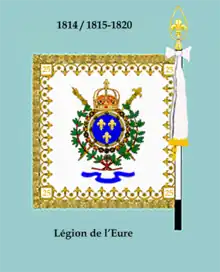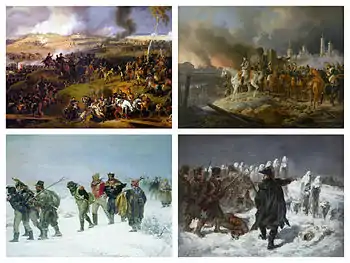Jean-François Gentil
Jean-François-Madeleine de Gentil (born in Artaise-le-Vivier on 8 March 1789 and died in Paris on 29 March 1852) was a French officer who participated to the French conquest of Algeria.[1]
Jean-François Gentil | |
|---|---|
| Birth name | Jean-François-Madeleine de Gentil |
| Born | 8 March 1789 Artaise-le-Vivier, |
| Died | 29 March 1852 Paris, |
| Allegiance | France |
| Branch | French Army, Armée des Émigrés, Army of Condé |
| Years of service | 1808-1852 |
| Rank | Divisional general |
| Battles/wars | |
| Awards | |
Family
Jean-François Gentil is the son of Louis-Français de Gentil who was squire and lord of Artaise-le-Vivier, and was a former officer in the 1st Infantry Regiment.[2]
His mother is the named Alexisse-Edmée de Meaux d'Armonville whom his father married and from whom he had nine children.[3]
His father emigrated to France during the year 1792 with three of his sons, including Jean-François Gentil, with whom he campaigned in the Armée des Émigrés.[4]
Military training
Jean-François Gentil was admitted to the École spéciale militaire de Saint-Cyr on 29 December 1808, from which he left on 27 July 1809 as a Sub-lieutenant in the "1er régiment de chasseurs-conscrits", which then became the "3e régiment de voltigeurs de la Garde impériale" of the "Jeune Garde".[5]
Military campaigns in Europe
Campaign and siege of Germany and Austria (1809)
As a sub-lieutenant in the "1er régiment de chasseurs-conscrits", he took part in the 1809 military campaign in Germany.[6]
Campaign of Napoleon I in Spain (1810–1811)

The sub-lieutenant that he was then in the same regiment also participated in the two military campaigns of 1810 and 1811 during the Peninsular War.[7]
Thus, after his return from Prussia, Gentil then reinforced the army corps that roamed the Iberian Peninsula, and he distinguished himself at the Siege of Astorga in the Kingdom of León from 21 March 1810.
Gentil therefore took part in this siege that history considers one of the finest feats of arms of the Spanish Civil War.
First military promotion
On 6 December 1811, he was appointed as a lieutenant officer in the "Régiment des flanqueurs-chasseurs" of the "Jeune garde".
On 15 December of the same year, he became lieutenant adjutant-major of the "1er régiment de voltigeurs" of the same weapon.
French invasion of Russia (1812)
Lieutenant Jean-François Gentil was part with the "1st regiment of voltigeurs" of the military campaign of 1812 in Russia.[8]
His feet froze during the fighting, and he lost the big toe of his right foot and two phalanges of two other fingers.
German campaign of 1813
After being promoted to the rank of Adjutant Major on 8 April 1813, he then took part in the German campaign of 1813.
He distinguished himself by his bravery and his fight in the Battle of Dresden, where he was shot in the left arm.
As a reward for his heroic conduct on this day of 26 August 1813, he received as a gratuity the medal of the cross of the Legion of Honour.
Campaign in north-east France (1814)
Captain Gentil actively participated in the French campaign led by the Sixth Coalition against the First French Empire, which took place from late December 1813 to April 1814.
While Napoleon was trying to stop the invasion of France and keep his throne, Captain Gentil was shot in the head in the Épinal affair dated 11 January 1814.
Hundred Days (1815)
During the reorganization of the French Army, he was incorporated with his rank of captain in the 3rd line infantry regiment.
It was then that in the Hundred Days period during 1815, he passed to the 4th regiment of voltigeurs of the new and young imperial guard.
He actively participated with this regiment in the campaign of the Army of the North during the spring of 1815.
First transitional phase (1815–1816)

The captain Gentil was dismissed and put on non-working leave on 22 September 22 1815 for a period of a whole year.
The following year when the departmental legions were created in France, Gentil was admitted as captain of the Eure legion on 20 November 1816.
Garde royale (1819)
In 1819, Marshal Laurent de Gouvion Saint-Cyr wanted to modify the organization and the military spirit of the French royal guard.
He then appointed Captain Gentil with several former officers of the Empire to be incorporated into this corps.
This is how Gentil passed with his rank of captain in the 4th regiment of the royal guard.
Second transitional phase (1828–1832)
Captain Gentil was included in the Royal Guard's dismissal list and was put on leave pay in 1828.[9]
He was not recalled to military activity until 8 November 1832 when he was appointed as battalion commander in the 49th line infantry regiment.[10][11]
French conquest of Algeria (1832–1847)
Promoted to the rank of Maréchal de camp, General Gentil was appointed at the beginning of 1844 to command the military subdivision and the territory of Algiers in Mitidja.[12][13][14]
This is how he took part on February 1846 in the expedition against the tribes of Khachna Massif within Kabylia and contributed powerfully to the success of the murderous fight of Ouarez-Eddin, which resulted in obtaining the submission of the Flissa tribe.[15][16][17]
Promotion to the rank of Major General (1848)
Jean-François Gentil was promoted to the rank of major general on 17 August 1848.[18]
Awards
Jean-François Gentil was decorated with several medals during his military career, including:[19]
- Knight of the Order of Saint Louis.[20]
- Officer of the Legion of Honour by decree dated 13 April 1846.[21]
- Officer of the Order of Leopold by Belgian royal decree dated 10 July 1847.[22]
Death
General Gentil died in the city of Paris on 29 March 1852 at the age of 63 and was buried in one of his cemeteries.[23]
The cause of his sudden death was due to the fact that he succumbed to an apoplexy in his family home.[24]
See also
- École spéciale militaire de Saint-Cyr
- Armée des Émigrés
- 1st Infantry Regiment
- Peninsular War
- Laurent de Gouvion Saint-Cyr
- French conquest of Algeria
- Thomas Robert Bugeaud
- Emir Abdelkader
- Emir Mustapha
- Ahmed bin Salem
- Louis Juchault de Lamoricière
- Aimable Pélissier
- Marie Alphonse Bedeau
- Nicolas Changarnier
- Louis-Eugène Cavaignac
Bibliography
- Nicolas Viton de Saint Allais (1816). Nobiliare universel de France, Volume 8. Paris: Saint Allais, Libraire. p. 194.
- Le moniteur de l'armée: 1852. Paris: Librairie Militaire. 1852. p. 2.
- Narcisse Faucon (1890). Le livre d'or de l'Algérie. Paris: Augustin Challamel, Éditeur. p. 602-605.
References
- Faucon, Narcisse (1890). "Le livre d'or de l'Algérie: Histoire politique, militaire, administrative; événements et faits principaux; biographie des hommes ayant marqué dans l'armée, les sciences, les lettres, etc., de 1830 à 1889".
- "Nobiliare universel de France, ou recueil général des généalogies historiques des maisons nobles de ce royaume". 1816.
- Saint-Allais, Nicolas Viton de (1874). "Nobiliaire universel de France ou recueil général des généalogies historiques des maisons nobles de ce royaume".
- "Nobiliaire de Bretagne, tiré littéralement des registres manuscrits originaux authentiques ... Avec une notice historique sur l'origine de la noblesse, etc". 1816.
- Pech De Cadel, F. (1893). "Histoire de l'école spéciale militaire de Saint-Cyr".
- "Lettres Inédites du Maréchal Bugeaud, Duc d'Isly (1808-1849)". 1922.
- Alègre, Léon (1880). "Notices biographiques du Gard: Canton de Bagnols".
- Fabry, Gabriel Joseph (1902). "Campagne de Russie (1812): Operations militaires (1er-10aout) Smolensk. Documents annexes I-II. [t.4] 11-19 aout. Documents annexes".
- Faucon, Narcisse (1890). "Le livre d'or de l'Algérie: Histoire politique, militaire, administrative; événements et faits principaux; biographie des hommes ayant marqué dans l'armée, les sciences, les lettres, etc., de 1830 à 1889".
- "Les guerres d'Afrique depuis la conquête d'Alger par les Français jusques et compris l'expédition de Kabylie en 1858. Avec un aperçu des différents faits militaires auxquels la France a pris part pendant cette période, et un résumé historique des principaux événements dont l'Algérie a été le théâtre dans les temps antérieurs ... Ouvrage enrichi de plans, vues, portraits ... Et d'une belle carte de l'Algérie". 1859.
- Piesse, Louis (1862). "Itinéraire historique et descriptif de l'Algérie, comprenant le Tell et le Sahara".
- Ducuing, Fr (1868). "Etudes historiques. La guerre de montagne, (Navarre 1834-35 et Kabylie 1841-47): Les dominations françaises Isyrie - Canada - Inde - Morée - Egypte - Plata".
- Piesse, Louis (1882). "Itinéraire de l'Algérie, de la Tunisie et de Tanger".
- "Le Correspondant". 1888.
- "Le Maréchal Bugeaud: d'Après sa correspondance intime et des documents inédits, 1784-1849". 1882.
- "Revue des deux mondes". 1851.
- Thureau-Dangin, Paul (1889). "Histoire de la monarchie de juillet".
- "Journal militaire officiel: 1848,[3], Sem. 2". 1848.
- "Almanach national". 1852.
- Viton), M. de Saint-Allais (Nicolas (17 February 1874). "Nobiliaire universel de France: ou Recueil général des généalogies historiques des maisons nobles de ce royaume". Au bureau du Nobiliaire universel de France, Réimprimé à la Librairie Bachelin-Deflorenne – via Google Books.
- Faucon, Narcisse (17 February 1890). "Le livre d'or de l'Algérie: histoire politique, militaire, administrative; événements et faits principaux; biographie des hommes ayant marqué dans l'armée, les sciences, les lettres, etc., de 1830 à 1889". A. Challamel – via Google Books.
- "Pasinomie: collection complète des lois, décrets, arrêtés et réglements généraux qui peuvent être invoqués en Belgique". Bruylant. 17 February 1847 – via Google Books.
- "Le moniteur de l'armée: 1852". 17 February 1852 – via Google Books.
- Valée, Comte Sylvain Charles (1949). "Correspondance du maréchal Valée: Janvier-Aout 1840".



